(完整word版)新模式英语1Unit6教案
- 格式:pdf
- 大小:73.49 KB
- 文档页数:5
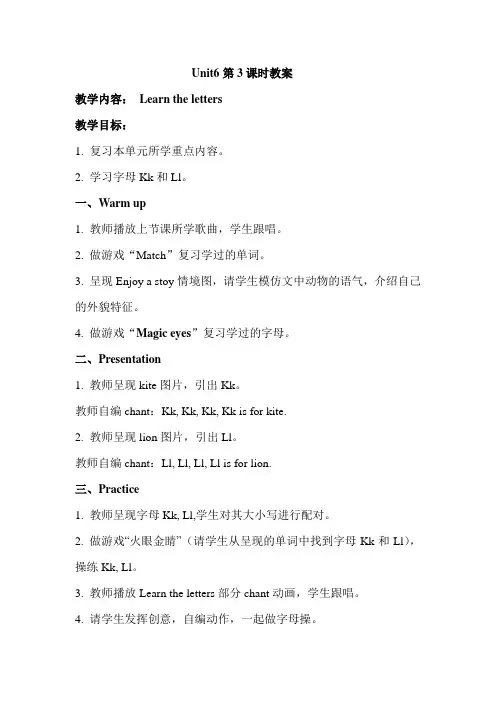
Unit6第3课时教案教学内容:Learn the letters教学目标:1. 复习本单元所学重点内容。
2. 学习字母Kk和Ll。
一、Warm up1. 教师播放上节课所学歌曲,学生跟唱。
2. 做游戏“Match”复习学过的单词。
3. 呈现Enjoy a stoy情境图,请学生模仿文中动物的语气,介绍自己的外貌特征。
4. 做游戏“Magic eyes”复习学过的字母。
二、Presentation1. 教师呈现kite图片,引出Kk。
教师自编chant:Kk, Kk, Kk, Kk is for kite.2. 教师呈现lion图片,引出Ll。
教师自编chant:Ll, Ll, Ll, Ll is for lion.三、Practice1. 教师呈现字母Kk, Ll,学生对其大小写进行配对。
2. 做游戏“火眼金睛”(请学生从呈现的单词中找到字母Kk和Ll),操练Kk, Ll。
3. 教师播放Learn the letters部分chant动画,学生跟唱。
4. 请学生发挥创意,自编动作,一起做字母操。
Kk, Kk, Kk, /k/, /k/, /k/Kk /k/ kite.Ll, Ll, Ll, /l/, /l/, /l/Ll /l/ lion.5. 教师播放Learn the letters部分字母动画,教学生书写字母Kk, Ll.6. 教师呈现一些生活中用到的字母或者相关图片,如:肯德基,logo。
拉夏贝尔,Kimi,Cayla7. 请学生说出更多生活中的字母。
四、练习:判断下列字母的大写和小写形式是(√)否(×)相符。
( ) 1. L b ( ) 2. K k( ) 3. B b ( ) 4. J g( ) 5. L l×√√×√五、Summary本节课学习的字母有Kk, Ll,代表单词kite,lion。
六、Homework1. 抄写字母Kk, Ll5遍,默写Aa—Ll1遍。
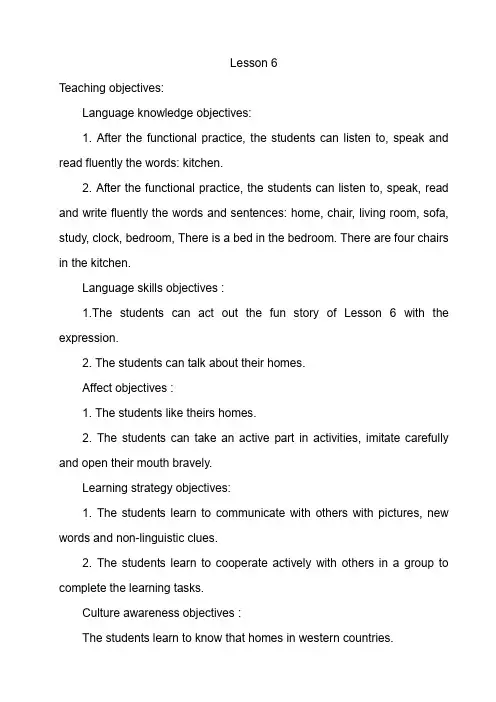
Lesson 6Teaching objectives:Language knowledge objectives:1. After the functional practice, the students can listen to, speak and read fluently the words: kitchen.2. After the functional practice, the students can listen to, speak, read and write fluently the words and sentences: home, chair, living room, sofa, study, clock, bedroom, There is a bed in the bedroom. There are four chairs in the kitchen.Language skills objectives :1.The students can act out the fun story of Lesson 6 with the expression.2. The students can talk about their homes.Affect objectives :1. The students like theirs homes.2. The students can take an active part in activities, imitate carefully and open their mouth bravely.Learning strategy objectives:1. The students learn to communicate with others with pictures, new words and non-linguistic clues.2. The students learn to cooperate actively with others in a group to complete the learning tasks.Culture awareness objectives :The students learn to know that homes in western countries.Key Points: To pay special attention to the new words and sentences. Difficult Points: Make sure that students use the new sentences correctly. Teaching Aids: ppt, word cards, recorder.Teaching procedures:Step 1 : Warming-up:1. Greeting: Good morning, boys and girls!2. Today, we will learn lesson 6.Step 2:Presentation:1. Look, this is my home. Today, Miss An wants to invite all of you to my home. Do you want to go with me?2. What’s in my home? Play a game: Look and say quickly.Step 3: Practice:1. First, let’s go into the bedroom. Look, there is a bed in the bedroom. (Write on the blackboard.) Let students read the sentence.2. Now this time, let’s go into the kitchen. Look, there are four chairs in the kitchen. (Write on the blackboard.) Let students read the sentence.3. Let students introduce something in my homes.There is _____.There are _____.4. Chant together:There is a big bed, in my bedroom, in my bedroom.There are two sofas, in my living room, in my living room.What’s in your study? There is a new computer.What’s in your kitchen? There are four chairs.5. Listening practice.Step 4: Consolidation:1.Show picture of Micky and Mimi. Let students listen the fun story, and answer question:Is this Micky’s home? A. Yes, it is. B. No, it isn’t.2. Listen the fun story again, and fill in the blanks.1) What are in the living room?are ___________ and __________.2) What are in the study?There’s __________ and __________.3) What are in the kitchen?There’s __________ and __________.a new desk six new chairsa big sofa a big fridgeabig clock four chairs3. Read the fun story with the tape.4. Read the fun story in pairs.5. Act out the fun story in pairs.Step 5: Summary:1. Writing exercise:My HomeHello! I am ________. Welcome to my home.This is my ________. There is a ________ in the ________.This is my ________. There is a ________ in the ________.This is my ________. There is a ________ in the ________.2. Watch a film, and then tell students.Love your mum and dad. And love your home!Step 6: Homework:1. What’s this in English? Let students find on the computer.2. Go on w riting “My home”Blackboard Design:Lesson 6There is a bed in the bedroom.There are four chairs in the kitchen.。
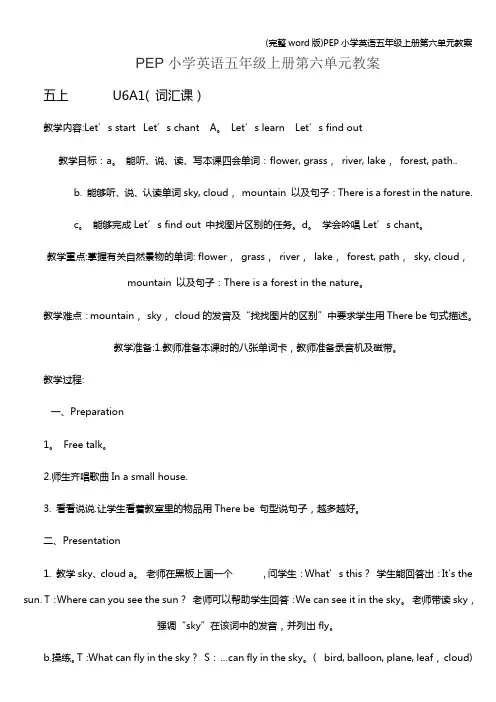
PEP小学英语五年级上册第六单元教案五上U6A1( 词汇课)教学内容:Let’s start Let’s chant A。
Let’s learn Let’s find out教学目标:a。
能听、说、读、写本课四会单词:flower, grass,river, lake,forest, path..b. 能够听、说、认读单词sky, cloud,mountain 以及句子:There is a forest in the nature.c。
能够完成Let’s find out 中找图片区别的任务。
d。
学会吟唱Let’s chant。
教学重点:掌握有关自然景物的单词: flower,grass,river,lake,forest, path,sky, cloud,mountain 以及句子:There is a forest in the nature。
教学难点:mountain,sky,cloud的发音及“找找图片的区别”中要求学生用There be句式描述。
教学准备:1.教师准备本课时的八张单词卡,教师准备录音机及磁带。
教学过程:一、Preparation1。
Free talk。
2.师生齐唱歌曲In a small house.3. 看看说说.让学生看着教室里的物品用There be 句型说句子,越多越好。
二、Presentation1. 教学sky、cloud a。
老师在黑板上画一个,问学生:Wh at’s this?学生能回答出:It's the sun. T:Where can you see the sun?老师可以帮助学生回答:We can see it in the sky。
老师带读sky,强调“sky”在该词中的发音,并列出fly。
b.操练。
T:What can fly in the sky?S:…can fly in the sky。
(bird, balloon, plane, leaf,cloud)c。
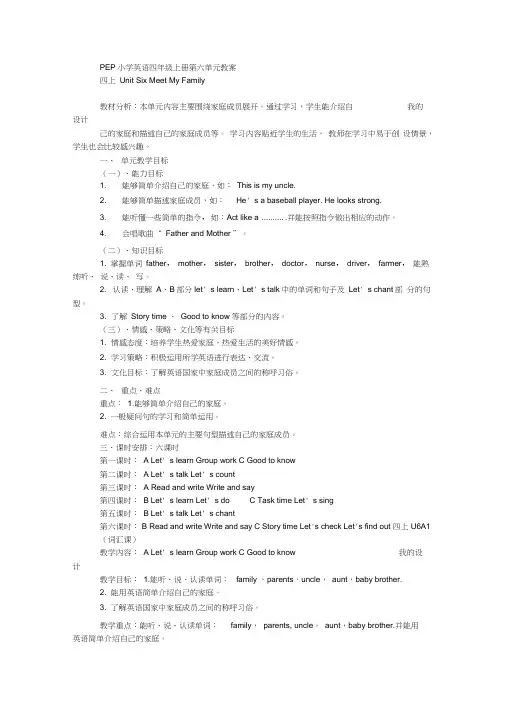
PEP小学英语四年级上册第六单元教案四上Unit Six Meet My Family教材分析:本单元内容主要围绕家庭成员展开。
通过学习,学生能介绍自我的设计己的家庭和描述自己的家庭成员等。
学习内容贴近学生的生活,教师在学习中易于创设情景,学生也会比较感兴趣。
一、单元教学目标(一)、能力目标1. 能够简单介绍自己的家庭,如:This is my uncle.2. 能够简单描述家庭成员,如:He' s a baseball player. He looks strong.3. 能听懂一些简单的指令,如:Act like a .......... .并能按照指令做出相应的动作。
4. 会唱歌曲“ Father and Mother ”。
(二)、知识目标1. 掌握单词father, mother, sister, brother, doctor, nurse, driver, farmer,能熟练听、说、读、写。
2. 认读、理解A、B部分let' s learn、Let' s talk中的单词和句子及Let' s chant部分的句型。
3. 了解Story time 、Good to know 等部分的内容。
(三)、情感、策略、文化等有关目标1. 情感态度:培养学生热爱家庭,热爱生活的美好情感。
2. 学习策略:积极运用所学英语进行表达、交流。
3. 文化目标:了解英语国家中家庭成员之间的称呼习俗。
二、重点、难点重点: 1.能够简单介绍自己的家庭。
2. 一般疑问句的学习和简单运用。
难点:综合运用本单元的主要句型描述自己的家庭成员。
三、课时安排:六课时第一课时: A Let' s learn Group work C Good to know第二课时: A Let' s talk Let' s count第三课时: A Read and write Write and say第四课时: B Let' s learn Let' s do C Task time Let' s sing第五课时: B Let' s talk Let' s chant第六课时:B Read and write Write and say C Story time Let's check Let's find out 四上U6A1 (词汇课)教学内容: A Let' s learn Group work C Good to know 我的设计教学目标: 1.能听、说、认读单词:family ,parents,uncle,aunt,baby brother.2. 能用英语简单介绍自己的家庭。
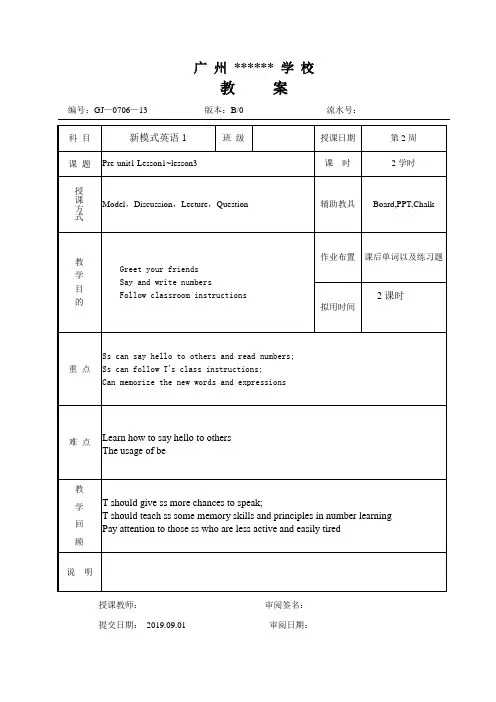
广州****** 学校教案编号:GJ—0706—13 版本:B/0 流水号:授课教师:审阅签名:提交日期:2019.09.01 审阅日期:教案编号:02 版本:中高等职业技术院校新模式英语系列教材流水号:02授课教师:审阅签名:提交日期:2019-9-15 审阅日期:教学过程教案编号:02 版本:中高等职业技术院校新模式英语系列教材流水号:02授课教师:审阅签名:提交日期:2019-9-15 审阅日期:教学过程教案编号:02 版本:中高等职业技术院校新模式英语系列教材流水号:02授课教师:审阅签名:提交日期:2019-9-15 审阅日期:教学过程教学环节与时间分配教学内容教学仪规教学日志5分钟新课导入10分钟新课讲授现场教学25分钟师生互动提问交流25分钟课堂小结10分钟Lesson3 Roberto ’s familyStep 1: 组织教学1、展示教学仪规,师生相互问好。
2、进行班级学生考勤点名,如实填写教学日志。
3、强调课堂纪律和教室卫生情况。
Step 2 Warming-up and revision.首先跟学生回顾一下上节课所讲的内容,在黑板上写出brother 和sister,问个别学生他们有多少兄弟姐妹,数一下全班一共有多少兄弟姐妹,说明教学目标:Today we will learn how to describe family relationships.Step 3 Presentation11)多媒体展示:用图片展示单词,教授学生对单词的听说读写,然后展现一个家谱图,帮助学生理清每个家庭成员的关系。
重点介绍侄子跟侄女与学生的关系,因为这两个单词相对其他单词比较陌生。
Step 4 practice1)完成课本听力的部分。
2) 学生之间互相询问,操练单词的读法跟拼写。
Step 5 Blackboard DesignT will draw a family tree on the blackboard, and then let ss draw on the paper教案编号:02 版本:中高等职业技术院校新模式英语系列教材流水号:02授课教师:审阅签名:提交日期:2019-9-15 审阅日期:教学过程教案编号:02 版本:中高等职业技术院校新模式英语系列教材流水号:02授课教师:审阅签名:提交日期:2019-9-15 审阅日期:教学过程教案编号:02 版本:中高等职业技术院校新模式英语系列教材流水号:02授课教师:审阅签名:提交日期:2019-9-15 审阅日期:教学过程教案编号:02 版本:中高等职业技术院校新模式英语系列教材流水号:02授课教师:审阅签名:提交日期:2019-9-15 审阅日期:教学过程教案编号:02 版本:中高等职业技术院校新模式英语系列教材流水号:02授课教师:审阅签名:提交日期:2019-9-15 审阅日期:教学过程教案编号:02 版本:中高等职业技术院校新模式英语系列教材流水号:02授课教师:审阅签名:提交日期:2019-9-15 审阅日期:教学过程教案编号:02 版本:中高等职业技术院校新模式英语系列教材流水号:02授课教师:审阅签名:提交日期:2019-9-15 审阅日期:教学过程教案编号:02 版本:中高等职业技术院校新模式英语系列教材流水号:02授课教师:审阅签名:提交日期:2019-9-15 审阅日期:教学过程教案编号:02 版本:中高等职业技术院校新模式英语系列教材流水号:02授课教师:审阅签名:提交日期:2019-9-15 审阅日期:教学过程教案编号:02 版本:中高等职业技术院校新模式英语系列教材流水号:02授课教师:审阅签名:提交日期:2019-9-15 审阅日期:教学过程教案编号:02 版本:中高等职业技术院校新模式英语系列教材流水号:02授课教师:审阅签名:提交日期:2019-9-15 审阅日期:教学过程教案编号:02 版本:中高等职业技术院校新模式英语系列教材流水号:02授课教师:审阅签名:提交日期:2019-9-15 审阅日期:教学过程。
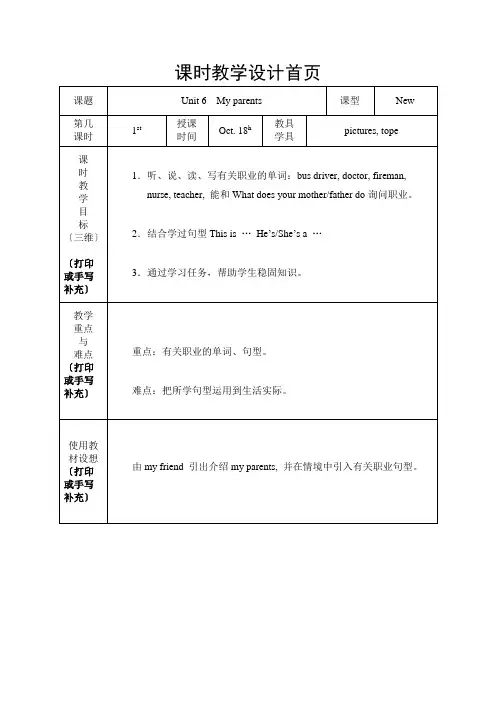
课时教学设计首页课时教学互动流程补充课时教学互动流程补充课时教学设计尾页☆补充设计☆课时教学设计首页课时教学互动流程补充课时教学互动流程补充课时教学设计尾页☆补充设计☆第二课时教学目标:知识目标1.能听、说、读、写本课的核心词汇:bee, insect, ant, kind2.能熟练掌握核心句型:What did you see at the museumI saw a lot of interesting cars.I bought a toy bee.3.能读懂关于参观博物馆的对话。
重点难点:1.能在语境中正确运用本课的核心词汇和句型。
2.一般现在时态与一般过去时态的混合使用。
教学用具:录音机、自制课件、照片等教学过程:StepⅠWarm up and revision〔热身与复习〕1.Sing an English song:please stand upT: Hello!Boys and girls .Nice to meet you !Ss: Hello!Teacher. Nice to meet you too .T: Let’s sing a song together.2.Do some warming-up exercises.3.Review the word of insects.Step ⅡPresentation and practice〔呈现新语言知识和练习〕1.Lead in.2.T: Let’s play a guessing game. We can see a lot of exciting films there.What place is itSs: It’s a cinema.T: You are right.!We can borrow books there. What place is itSs: It’s a library.T: We can see and learn about many interesting things there.It’s a museum.3.Show some photos and introduce all kinds of museums.4.Learn to say and use the words.T: What did you see at the insect museumSs: We saw many insects.5.Watch the screen and learn to say the sentences.6.Ask pupils to practise in groups .Sept ⅢLearn the story 〔学习课文〕1.Ask the pupils to look at the pictures on the textbooks and talk about them in groups.2.Watch the cartoon.3.Students follow the recording to read the story.4.The pupils read the text carefully. And then try to do some exercises.5.Role- play in pairs.。
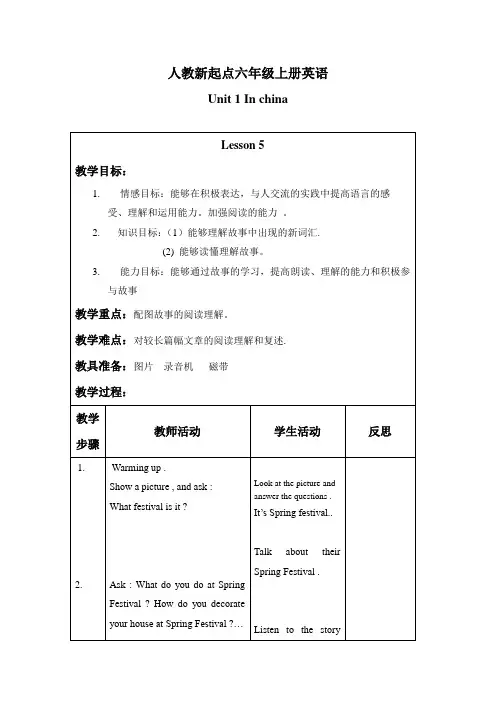
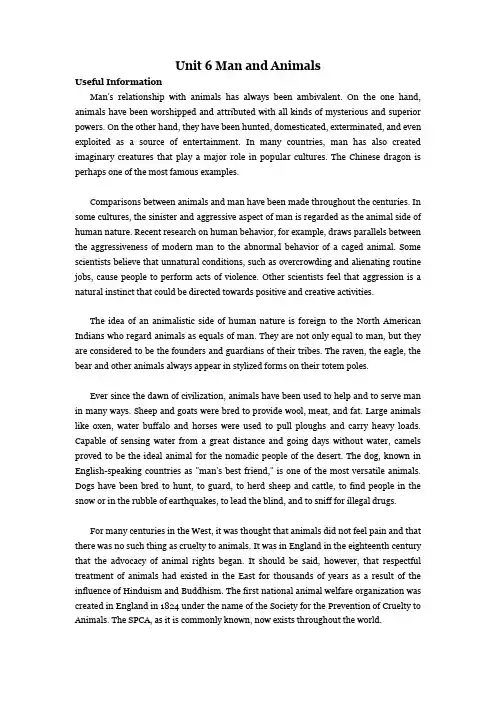
Unit 6 Man and AnimalsUseful InformationMan's relationship with animals has always been ambivalent. On the one hand, animals have been worshipped and attributed with all kinds of mysterious and superior powers. On the other hand, they have been hunted, domesticated, exterminated, and even exploited as a source of entertainment. In many countries, man has also created imaginary creatures that play a major role in popular cultures. The Chinese dragon is perhaps one of the most famous examples.Comparisons between animals and man have been made throughout the centuries. In some cultures, the sinister and aggressive aspect of man is regarded as the animal side of human nature. Recent research on human behavior, for example, draws parallels between the aggressiveness of modern man to the abnormal behavior of a caged animal. Some scientists believe that unnatural conditions, such as overcrowding and alienating routine jobs, cause people to perform acts of violence. Other scientists feel that aggression is a natural instinct that could be directed towards positive and creative activities.The idea of an animalistic side of human nature is foreign to the North American Indians who regard animals as equals of man. They are not only equal to man, but they are considered to be the founders and guardians of their tribes. The raven, the eagle, the bear and other animals always appear in stylized forms on their totem poles.Ever since the dawn of civilization, animals have been used to help and to serve man in many ways. Sheep and goats were bred to provide wool, meat, and fat. Large animals like oxen, water buffalo and horses were used to pull ploughs and carry heavy loads. Capable of sensing water from a great distance and going days without water, camels proved to be the ideal animal for the nomadic people of the desert. The dog, known in English-speaking countries as "man's best friend," is one of the most versatile animals. Dogs have been bred to hunt, to guard, to herd sheep and cattle, to find people in the snow or in the rubble of earthquakes, to lead the blind, and to sniff for illegal drugs.For many centuries in the West, it was thought that animals did not feel pain and that there was no such thing as cruelty to animals. It was in England in the eighteenth century that the advocacy of animal rights began. It should be said, however, that respectful treatment of animals had existed in the East for thousands of years as a result of the influence of Hinduism and Buddhism. The first national animal welfare organization was created in England in 1824 under the name of the Society for the Prevention of Cruelty to Animals. The SPCA, as it is commonly known, now exists throughout the world.The animal rights movement has grown considerably in recent decades. As a result of protests by animal rights groups, hunting of endangered species has been banned in most countries. Many efforts have been made, for example, to stop the killing of elephants by hunters participating in the ivory trade. Some animal rights groups have focused their attention on the treatment of animals in scientific research and on the use of animals in the testing of beauty products such as perfumes, creams and makeup. Zoos and pet stores are now constantly inspected and criticized by animal rights groups. Many people regard zoos as cruel environments and favor safari parks where animals are free to roam in a more natural setting.The destruction of forests and other natural habitats has resulted in the disappearance of many species of animals throughout the world. Wildlife protection organizations have conducted educational campaigns drawing public attention to the serious decline in the biological diversity of the planet as more and more species disappear because of pollution and industrial development.Part One Preparation1. Word Associationant, antelope(羚羊), bat, bear, beaver, bee, bird, bull, butterfly, camel, cat, chicken, cod, cow, crab, crocodile, cuttlefish (乌贼), deer, dog, dolphin, donkey, dragonfly, duck, eagle, eel, elephant, fish, fly, fox, frog, goat, goose, giraffe, hippo (河马), horse, koala, leopard, lion, lizard, mandarin duck(鸳鸯), monkey, mosquito, mouse, mule, ostrich, owl, ox, panda, parrot, peacock, penguin, pig, pigeon, pony, rabbit, rat, rhino (犀牛), salmon, scorpion (蝎), sea lion, shark, sheep, shrimp, skunk, snail, snake, spider, squirrel, swallow, tiger, tortoise, turkey, turtle, weasel (黄鼠狼), whale, worm, zebra, etc.2. Test Your Animal KnowledgeDirections: Finish the quiz individually, then compare your answers with your neighbors’.Part I: What is it?1) A squirrel 2) An owl 3) A dolphin 4) A tiger 5) A monkey 6) A dog 7) A beaver 8) A lion 9) A penguin 10) An ostrichPart II: Which is the best choice?1) B 2) C 3) D 4) C 5) B6) A 7) D 8) C 9) C 10) C3. Interesting Facts about Animals (More for teachers’ reference)1. A newborn kangaroo is about 1 inch in length.2.Each year, insects eat 1/3 of the Earth's food crop.3. A rat can last longer without water than a camel can.4. A cow gives nearly 200,000 glasses of milk in her lifetime.5.The only domestic animal not mentioned in the Bible is the cat.6. A bird requires more food in proportion to its size than a baby or a cat.7.The animal responsible for the most human deaths world-wide is the mosquito.8.There are more than 100 million dogs and cats in the United States. Americansspend more than 5.4 billion dollars on their pets each year.4. The Pet ShowMay: dog, speak, thirdBeth: bird, jump, firstKim: snake, roll over and play dead, secondSince the snake rolls over (clue #3) and the bird does not speak (clue #2), the bird must jump. The pet that jumps took first place (clue #4), and the bird is owned by Beth (clue #5), so Beth owns the first-place pet. Since Beth owns the first-place pet and May owns the third-place pet (clue #1), then Kim must own the second-place pet. Since the snake took second (clue #6), it must belong to Kim. If Beth owns the bird, and Kim owns the snake, then May must own the dog. Since the bird jumps and the snake rolls over, the dog must speak. Since May owns the dog, and May’s pet took third, the dog must be the third-place pet.Part Two Reading-Centered ActivitiesI. Pre-Reading–Yes, extremely frightened. I’m terrified of th em because I feel they can easily become fierce and nasty. They attack and bite people. They also carry diseases.–No, not at all. Actually I love dogs and we keep a dog at home. When I’m at home, the dog will be always around me. We often share food at meal time. For example, I have the meat and she’ll eat the bone. We’re very good friends.When they are threatened;When they are attacked or hurt;When they want to protect their young;When they are cornered.When they are put in certain situations:in war;in self-defense;when they are extremely angry;when they lack space and freedom.4) Fighting, beating, slapping, invasion, war, etc.II. In-Class ReadingWords, Phrases and Grammatical PointsSome zoologists and psychologists compare modern man to a caged lion.―compare…to…‖ 除了有―把……比作……‖的意思外,还有―把……与…比较‖的意思(可用―compare…with…‖ 来替代)。
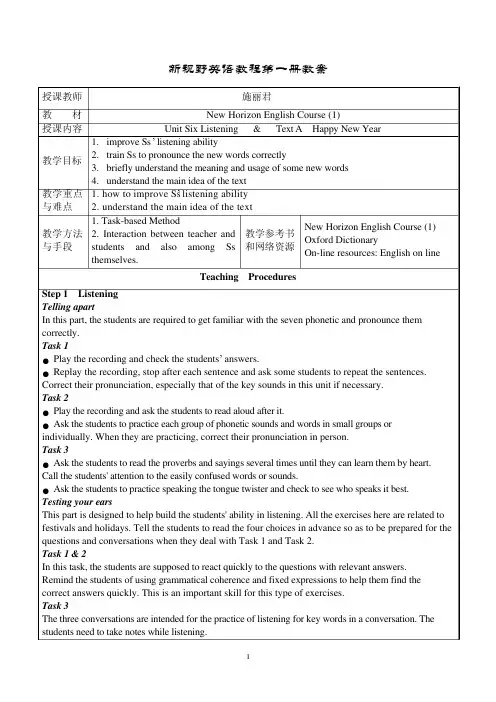
新视野英语教程第一册教案授课教师施丽君教材New Horizon English Course (1)授课内容Unit Six Listening & Text A Happy New Year教学目标1.improve Ss’ listening ability2.train Ss to pronounce the new words correctly3.briefly understand the meaning and usage of some new words4.understand the main idea of the text教学重点与难点1. how to improve Ss’ listening ability2. understand the main idea of the text教学方法与手段1. Task-based Method2. Interaction between teacher andstudents and also among Ssthemselves.教学参考书和网络资源New Horizon English Course (1)Oxford DictionaryOn-line resources: English on lineTeaching ProceduresStep 1 ListeningTelling apartIn this part, the students are required to get familiar with the seven phonetic and pronounce them correctly.Task 1● Play the recording and check the students’ answers.● Replay the recording, stop after each sentence and ask some students to repeat the sentences. Correct their pronunciation, especially that of the key sounds in this unit if necessary.Task 2● Play the recording and ask the students to read aloud after it.● Ask the students to practice each group of phonetic sounds and words in small groups or individually. When they are practicing, correct their pronunciation in person.Task 3● Ask the students to read the proverbs and sayings several times until they can learn them by heart.Call the students' attention to the easily confused words or sounds.● Ask the students to practice speaking the tongue twister and check to see who speaks it best.Testing your earsThis part is designed to help build the students' ability in listening. All the exercises here are related to festivals and holidays. Tell the students to read the four choices in advance so as to be prepared for the questions and conversations when they deal with Task 1 and Task 2.Task 1 & 2In this task, the students are supposed to react quickly to the questions with relevant answers.Remind the students of using grammatical coherence and fixed expressions to help them find the correct answers quickly. This is an important skill for this type of exercises.Task 3The three conversations are intended for the practice of listening for key words in a conversation. The students need to take notes while listening.Step 2 Leading inTopic: Celebration of holidaysAll of us love holidays! However old we get, we all get excited about special days in our culture. Food, family, friends and fireworks are all big parts of enjoying these occasions. Ways to celebrate the holidays are various in different cultures all ove r the world. Let’s learn something about them.Step 3 ExploringThe following warming-up activities may help to raise your awareness of the differences in celebrating holidays.1. The following are three open-ended questions. Give your answer to each question and then tell us why.1) Do you like holidays?A. Yes, I like it very much.B. So so.C. No, not at all.2) Which is your favorite holiday?A. The Spring Festival.B. International Labor Day.C. The Mid-Autumn Festival.D. Christmas.3) What do you us ually do on New Year’s Day?A. Go to parties.B. Visit relatives.C. Visit friends.D. Have a family reunion.2. In this section, you’ll hear a short talk about bring good luck to the New Year. While listening, try to complete the following chart with the information you hear. (P94)Step 5 Listening (Text)The teacher lets the students listen to the text and try to read after the tape.Step 6 Homework1. Read the new words and text after class2. Underline some words, phrases or sentences that you consider important or difficult.新视野英语教程第一册教案授课教师施丽君教材New Horizon English Course (1) 授课内容Text A Happy New Year教学目标1. Grasp some keys words, phrases and some useful sentence patterns.2. Understand the structure and the main idea of the text.3. Practice the reading skill.教学重点与难点1. understand the structure of the text2. language points教学方法与手段1. Task-based Method2. Interaction between teacher andstudents and also among Ssthemselves.教学参考书和网络资源New Horizon English Course (1)Oxford DictionaryOn-line resources: English on lineTeaching ProceduresStep 1 ReviewThe teacher begins with the assignment mainly to have a review of the functional and notional language the students picked up in the previous class.Step 2 Spot dictationDirections: The following paragraph is taken from Text A. Listen carefully and fill in the blanks without referring to the original text.You can (1)__________ that after all that (2) __________, many (3) __________ begin the first day of the New Year a little (4) _______. They are (5) __________ quite happy to spend a (6)__________ day at home, (7) __________ the most (8) __________ New Year’s Day (9) __________ on (10) ___________.Step 3 ScanningThe teacher asks the Ss to scan the text and try and do the exercise on P99.Step 4 SkimmingThe teacher asks the students to read the text again and find the structure of it.Text A is about New Year’s celebrations and its structure goes like this: The writer first introduces the topic by telling us that different countries throughout the world give different importance to the New Year. Then he tells us the ways to celebrate the New Year in the USA.Introduction: Different countries throughout the world give different importance to the New Year. (Para. 1)Main body: The ways to celebrate the New Year in the USA. (Paras. 2--6)A.Having a big (usually noisy) party at home or in a hotel. (Paras. 2--3)B.Watching the New Year’s Eve celebrations in Times Square on TV. (Paras. 4--5)C.Making a New Year’ resolution. (Para. 6)Step 5 Analysis on the important language points.◆eve n.【1】[U](宗教节日或者假日的)前夜;前夕e.g. We’re giving a party on Christmas Eve.【2】(重大事件发生的)前夕;前一刻e.g. On the eve of the election, no one was confident enough to predict the result.◆celebrate v. 庆祝;举行(仪式、庆典)e.g. We celebrated her birthday with a party by going out to a restaurant.celebration n. [C; U]庆祝;庆祝会e.g. The party was in celebration of their parents’ golden wedding anniversary.◆ancient adj.【1】古代的e.g. The story took place in ancient Greece.【2】古老的;旧的e.g. In Rome, we visited some ancient temples.◆measureV.【1】量出或者记录(长度、温度等)e.g. A clock measures time.【2】度量(大小、长短、数额、程度等)e.g. How does a teacher measure his students’ success?n.【1】措施;方法e.g. The government has promised to take measures to help the unemployed.【2】量度单位e.g. Hour is a measure of time.◆Please pay close attention to the usage of the word “reason”:The reason for my absence was that I was ill. (Correct)The reason for my absence was because I was ill. (Wrong)Also, study the following, as they are both correct:The reason he was driving so fast was that he would be late for an important meeting. The reason why he was driving so fast was that he would be late for an important meeting.◆give importance to + n. 重视e.g. People give importance to this celebration.◆even/still + a./ad. 比较级更加······,作程度状语。
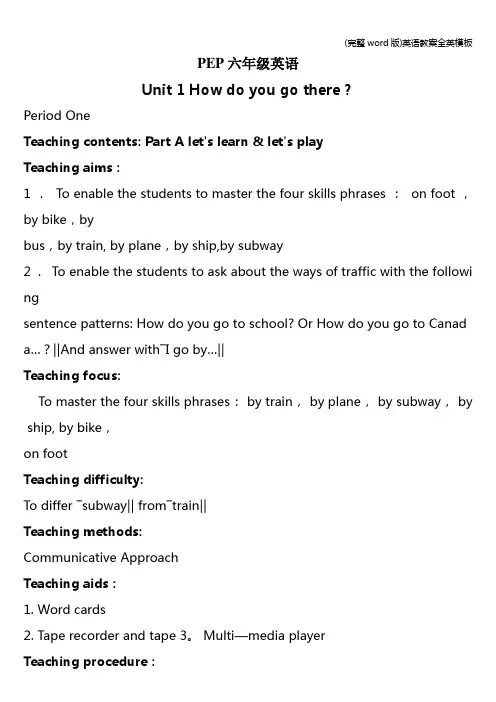
PEP六年级英语Unit 1 How do you go there?Period OneTeaching contents: Part A let's learn & let's playTeaching aims:1. To enable the students to master the four skills phrases: on foot,by bike,bybus,by train, by plane,by ship,by subway2. To enable the students to ask about the ways of traffic with the followi ngsentence patterns: How do you go to school? Or How do you go to Canad a…?‖And answer with―I go by…‖Teaching focus:To master the four skills phrases: by train, by plane, by subway, by ship, by bike,on footTeaching difficulty:To differ ―subway‖ from―train‖Teaching methods:Communicative ApproachTeaching aids:1. Word cards2. Tape recorder and tape 3。
Multi—media playerTeaching procedure:1。
(Warm—up)Greeting: Good morning , class ! Glad to meet you again. How are y ou?What day is it? What ‗s the date?What‘s the weather like today?2. PresentationShow a picture of busT: What‘s this? S: It‘s a bus.T: I go to school by bus。
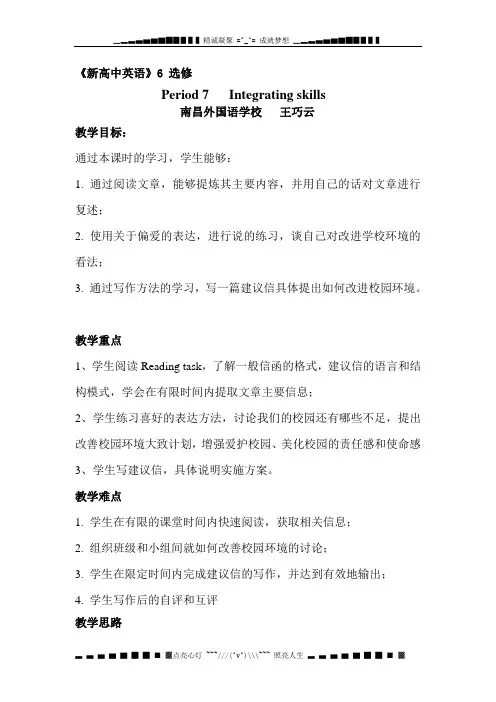
《新高中英语》6 选修Period 7 Integrating skills南昌外国语学校王巧云教学目标:通过本课时的学习,学生能够:1. 通过阅读文章,能够提炼其主要内容,并用自己的话对文章进行复述;2. 使用关于偏爱的表达,进行说的练习,谈自己对改进学校环境的看法;3. 通过写作方法的学习,写一篇建议信具体提出如何改进校园环境。
教学重点1、学生阅读Reading task,了解一般信函的格式,建议信的语言和结构模式,学会在有限时间内提取文章主要信息;2、学生练习喜好的表达方法,讨论我们的校园还有哪些不足,提出改善校园环境大致计划,增强爱护校园、美化校园的责任感和使命感3、学生写建议信,具体说明实施方案。
教学难点1. 学生在有限的课堂时间内快速阅读,获取相关信息;2. 组织班级和小组间就如何改善校园环境的讨论;3. 学生在限定时间内完成建议信的写作,并达到有效地输出;4. 学生写作后的自评和互评教学思路本课是普通高中课程标准实验教科书《英语》6(选修)第一单元练习册的Reading task, speaking task 和writing task。
该单元主题为Art,本课是单元最后一个课时,主要是通过本单元前面所学内容的积累,由学习的输入转化为以口语和写作形式的教学输出环节。
在学习本课之前,学生已在前面学习中初步了解了西方艺术的几个发展阶段、主要的绘画艺术流派和纽约曼哈顿的五大绘画展览厅,重点学习了虚拟语气在条件句和宾语从句中的用法。
在本课时的教学中,我将完成的三个板块,分别是读的任务、说的任务和写的任务。
这三个板块联系紧密,通过教师有效的导入和呈现可以很自然的上一节读说写的技能整合课,并采用了罗晓杰的“三段七步读写技能整合教学”来设计并进行教学。
本节课的Reading task是由一位名为Jo Ryan的同学代表全班就如何改善校园环境给校长Mrs. L Kroll写的一封建议信。
教材针对阅读文本设计了一个表格,但如果完全按照表格处理教材会显得突兀、不连贯而且无法体现学生的创造力和阅读能力。
新视野大学英语读写教程第一册Unit6教案有效,包括课前准备,课时安排,当堂活动,作业设计等Unit 6 : The Power of NatureⅠ. Pre-class PreparationTeacher’s Activities:1. Clarify the aims of this unit.2. Overview the text structure and the main points of this text.3. Introduce some related background knowledge.4. Briefly introduce some language points.Student’s Activities:1. Review the last lesson or the text if necessary.2. Think about the aims of this unit.3. Try to predict the contents of this text.Ⅱ. While-class ActivitiesTeacher’s Activities:1. Finish introducing the language points.2. Lead-in:Show some pictures about the power of nature and let students talk about the power of nature in small groups.3. Ask questions and check their understanding of the text.4. Lead-out:Teach some new words in this text with students.Student’s Activities:1. Listen to the teacher carefully and try to understand the language points.2. Talk about the related topics in small groups.3. Discuss the questions with their partners or groups.4. Learn the new words and be able to use them in theirdaily life.Ⅲ. Post-class ActivitiesTeacher’s Activities:1. Assign the homework.2. Summarize the key points of this lesson.Student’s Activities:1. Read the text again and try to find some more information about the power of nature.2. Write an essay about the power of nature.3. Review the language points and try to find more related knowledge.Ⅳ. Homework1. Read this text again and try to find more related information.2. Write an essay about the power of nature and share it with other students.3. Review the new words and try to use them in your daily life.。
教学目标:1. 知识目标:(1)掌握课文中的生词和短语;(2)理解课文的主要内容和结构;(3)了解不同文化背景下的人生哲学。
2. 能力目标:(1)提高阅读理解能力;(2)提高口语表达能力;(3)提高小组讨论和合作能力。
3. 情感目标:(1)激发学生对生活的热爱和追求;(2)培养学生的独立思考能力;(3)增强学生的文化意识。
教学重点:1. 课文中的重点词汇和短语;2. 课文的主旨和结构;3. 不同文化背景下的人生哲学。
教学难点:1. 理解并运用课文中的复杂句型;2. 分析并比较不同文化背景下的人生哲学。
教学准备:1. 课件或黑板;2. 课文原文;3. 生词卡片;4. 小组讨论话题。
教学过程:一、导入(5分钟)1. 教师简要介绍课文背景,激发学生兴趣;2. 学生自由发言,分享自己对生活的看法。
二、课文讲解(20分钟)1. 教师引导学生朗读课文,注意生词和短语;2. 逐段讲解课文,解释生词和短语;3. 分析课文结构,总结文章主旨。
三、词汇学习(10分钟)1. 教师展示生词卡片,学生跟读;2. 学生分组讨论,用生词造句;3. 教师点评,纠正错误。
四、小组讨论(15分钟)1. 分组讨论以下话题:a. 你认为什么才是真正的幸福?b. 在你看来,东西方文化在人生哲学上有哪些差异?2. 各小组派代表发言,分享讨论成果。
五、课堂小结(5分钟)1. 教师总结本节课所学内容;2. 强调重点词汇和短语;3. 鼓励学生在生活中践行课文中所提到的人生哲学。
六、课后作业(5分钟)1. 课后阅读课文,加深对文章的理解;2. 结合自己的生活经历,写一篇关于人生哲学的短文。
教学反思:本节课通过讲解课文、词汇学习、小组讨论等方式,帮助学生掌握课文中的重点内容,提高阅读理解能力和口语表达能力。
同时,引导学生关注不同文化背景下的人生哲学,培养学生的文化意识。
在教学过程中,要注意关注学生的学习状态,及时调整教学策略,确保教学效果。
《unit6 Meet my family》精品教案1、教学内容:小学英语四年级上册Unit 6 Meet My Family!第一课时,本单元的教学应充分利用Unit 3 My Friends旧知识,从而降低学习难度,并使知识得以循环巩固。
2、教学目标:知识目标能够听说认读单词:family , parent , uncle , aunt , baby brother. 能力目标:能用英语简单介绍自己的家庭,如This is my uncle.能听懂价绍家庭成员时使用的语言。
情感目标:(1)培养学生热爱家庭,热爱生活的美好情感。
(2)了解英语国家中家庭成员之间的称呼习俗。
3、教学重难点:重点:使学生掌握五个生词,并能在情景中运用。
难点:能用英语简单介绍自己的家庭。
教学过程Step 1 Warm – up课前歌曲《I love my family》Greeting:T: Good morning, boys and girls!Ss: Good morning, teacher!T: How are you?Ss: Fine, and you?T: I’m fine.T:There are some questions.Ss: Yes!1: Are you strong?Ss: Yes!2: Do you have a brother?Ss: Yes!3: Do you have a sister?Ss: Yes!4:Do you love your father?Ss: Yes!T:I love my father and mother,do you love your father and mother? Ss: Yes!Now let’s sing a song about our father and mother , ok ?T:This is my father and mother. This is my parents! In our family , we can call our father or mother parent ; we call our father and mother parents .What’s the meaning ?(师手指图片帮助学生理解parent和 parents 的区别。
Unit 1 Can you play the guitar?第一课时Section A (1a-2d)一、教学目标:1。
语言知识目标:1) 能掌握以下单词:guitar, sing, swim,dance,chess,play chess,draw,speak, speak English,join,club能掌握以下句型:①—Can you play the guitar? —Yes, I can./ No,I can't。
②-What can you do?-I can dance。
③—What club do you want to join? —I want to join the chess club。
2) 能了解以下语法:情态动词can的用法want to do sth。
的用法2。
情感态度价值观目标:该部分内容贴近学生的生活,谈论的话题是能力。
通过互相询问或谈论自己或对方在某一方面的能力,可以培养学生的一种群体意识。
二、教学重难点1. 教学重点:1)学习询问和谈论彼此的能力和特长;2) 掌握一些弹奏乐器的表达方式。
2。
教学难点:情态动词can的构成和使用。
三、教学过程Ⅰ. Lead in1. 教师可携带一些易于演奏的乐器,也可带一些演奏乐器的图片,一边演示乐器,一边说:I canplay the guitar.…等;再指着图片说:He/She can play the violin.But I can’t play it.等;然后询问学生:Can you play the guitar?….并引导学生进行简单的回答。
2. Ss look at the picture in 1a。
Then read the words and phrases。
Let Ss match theactivities with the people。
Then Check the answers with the class together。